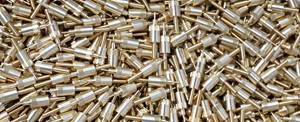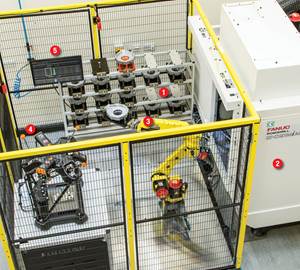Digital Twin Provides Real-Time Feedback on Part Quality
By gathering data directly from the sensors of the CNC machine, the digital twin offered by Gemineering can identify whether a part is in tolerance and even identify the moment in the toolpath when a part fails to achieve tolerance.
Share





Digital twins are the crystal balls of the machining world, predicting problems before they occur and enabling the user to find solutions without scrapping parts or damaging spindles. Digital representations of parts and machine work envelopes enable users to analyze and archive tool paths, providing machinists with the chance to make well-informed decisions before ever loading a workpiece into the machine tool.
The Gemineers interface in this image shows the readout from the DMU 75 Monoblock next to it. The system connects to the machine tool through a single ethernet cable and provides real-time feedback easily accessed at the machine station.
Source: Eli Plaskett
While the term “digital twin” is widely understood within the manufacturing industry to be a digital representation of a machine tool and the physical objects located within its work area, the term is less specific than many realize. “Digital twin is not my favorite wording,” say Satoshi Tanaka, GM of Technium USA, a DMG MORI company. “It can mean too many things.” For example, how is the data feeding the digital twin being collected? Is it using visual scans or touch probes? Is it using CNC data? Is it importing CAD data from a machine library? And that is not even touching on the variety of purposes companies have designed digital twins to fulfill: Some are intended purely to analyze tool paths for collision prevention, while others can also validate programs to prevent part errors.
, a company based in Aachen, Germany, opted to use a direct connection to the CNC to collect data, and the direct access to machine kinematics and axial movement has enabled the company to not only validate tool paths ahead of machining, but also provide real-time feedback on part quality.
Digital Accuracy
Gemineers began as joint project between RWTH Aachen University and the Fraunhofer Institute for Production Technology. In 2019, the project spun off into a company focused on providing an advanced digital twin capable of more than collision detection. To do this, the company developed software that collects data such as axial positioning or even vibration (where possible) directly from the CNC, then combines that data to calculate second order information such as pressure on the cutting tool. Gemineers then shows this informationon a digital screen connected to the CNC by an ethernet cable, making installation fairly simple.
The Here we see a turbine disc’s surface area as represented in the Gemineers system, with various features represented in different colors depending on variance from tolerance. The software captures and catalogues all tool movements, making it simple to identify where in the toolpath a part failed to achieve tolerance. Source: DMG MORI
Early in its life as an independent company, Gemineers connected with DMG MORI through the latter company’s longstanding relationship with the university. “DMG MORI immediately saw the promise in this technology,” Tanaka says, and Gemineers saw the promise in partnering with DMG MORI. “Because is connects directly to the CNC,” Tanaka explains, “the accuracy of the machine tool directly correlates to the accuracy of the digital twin.” . The system tracks real-time data, including exact locations within the work envelope, axial and spindle loads, positional errors, and how closely the part is to spec, all with an accuracy of ±10 microns and displayed on a screen next to the machine tool. This level of accuracy provides numerous benefits, enabling the user to not only validate the tool path, but to identify errors in the profile of the part as they occurr.
Tanaka demonstrated the system’s error-catching functionality to me using a captured tool path. Because the system archived the tool path and part data, he went through the tool path and identified the precise movements that occurred when the part failed to achieve tolerance. Additionally, the user can look at the axial positions, G code, spindle load, spindle speed and axial load at that moment to identify the problem with as much accuracy as possible. “The user can look at this data and make an informed decision about what the fix should be,” Tanaka says.
For example, a user experiencing cutting tool breakage can look at the data and identify the moment in the tool path when the spindle load spikes, then adjust the program to avoid that spike and save the company the costs of broken cutting tools and scrapped parts.
The system is not only useful for catching errors, however, as its detailed breakdowns of machining conditions provide multiple opportunities for machine shops to operate more efficiently.
More Than Error Prevention
According to Tanaka, the Gemineers digital twin can greatly benefit prototyping. “If you’re prototyping and want to validate two or three different tool paths, we can capture all of them,” he says. The user can then look at the actual cutting conditions and features, identifying which tool path is more efficient while still machining parts to tolerance. Additionally, when unanticipated errors occur, the shop can more easily identify the point of error and adjust the tool path or machining parameters.
This infographic shows the principles of the Gemineers system. It collects data such as positions, orientations, spindle and drive loads, and temperature to calculate cutting force, tool deflection and tool wear. It provide this information on a screen the user can interact with at the machine tool. Source: DMG MORI
Indeed, shops that work with prototyping may see the greatest benefit from this system, as it greatly speeds the process of diagnosing errors. Moreover, it may prevent machinists from discarding approaches to machining a part during the prototyping phase by clearly identifying failure points in a way that enables the machinist to subtly adjust the tool path instead of completely reworking it when failure points are difficult to find.
Additionally, Tanaka says that Gemineers’ digital twin can achieve high enough precision to minimize the need for quality inspection. “Obviously, shops will still need QA,” he explains, “but for certain parts the role of QA may shift. For example, parts that require multiple gaging and verification steps can derive a great benefit from validating during the machining process.” This means possibly eliminating steps that require machinists to halt machining to apply gages and measure specific features.
Of course, such benefits depend on the quality of the data provided by the CNC. “Because the data gathered comes directly from the CNC,” Tanaka explains, “machine tools with less accurate designs will provide less accurate data.” This means that features like heavy machine beds, damping systems, cooling systems in the machine body that prevent thermal distortion, and excellent kinematics are necessary to reap the greatest benefit from this system. “Not every machine tool is equipped to benefit from this digital twin,” Tanaka says, “but for those that are, the benefits are very exciting to us.”
Related Content
Protecting Your Automation Investments
Shops need to look at their people, processes and technology to get the most of out their automation systems.
Read MoreReinventing a Precision Shop With a Data-Driven Mindset
When this machine shop lost 90% of its business within three months, a reinvention was in order. Here's how it survived after quickly falling on hard times.
Read MoreHow this Job Shop Grew Capacity Without Expanding Footprint
This shop relies on digital solutions to grow their manufacturing business. With this approach, W.A. Pfeiffer has achieved seamless end-to-end connectivity, shorter lead times and increased throughput.
Read More5 Stages of a Closed-Loop CNC Machining Cell
Controlling variability in a closed-loop manufacturing process requires inspection data collected before, during and immediately after machining — and a means to act on that data in real time. Here’s one system that accomplishes this.
Read MoreRead Next
Digital Twin Provides Real-Time Feedback on Part Quality
By gathering data directly from the sensors of the CNC machine, the digital twin offered by Gemineering can identify whether a part is in tolerance and even identify the moment in the toolpath when a part fails to achieve tolerance.
Read MoreAMRs Are Moving Into Manufacturing: Considerations for Implementation
AMRs can provide a flexible, easy-to-use automation platform so long as manufacturers choose a suitable task and prepare their facilities.
Read MoreLast Chance! 2025 Top Shops Benchmarking Survey Still Open Through April 30
Don’t miss out! 91ÊÓƵÍøÕ¾ÎÛ's Top Shops Benchmarking Survey is still open — but not for long. This is your last chance to a receive free, customized benchmarking report that includes actionable feedback across several shopfloor and business metrics.
Read More






















